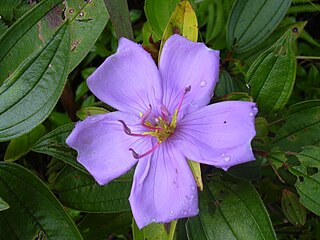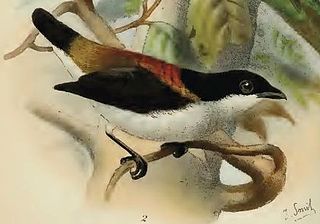
Melastoma is a genus in the family Melastomataceae. It has over 100 species distributed around Southeast Asia, India, north to Japan, south to Australia and the Pacific Islands. The number of species should probably be reduced according to some sources. Many species have been planted around the world for the aesthetic value of their bright purple flowers.

The Cebu flowerpecker is a small passerine bird. It is endemic to Cebu Island in the Philippines. Feared to have become extinct early in the 20th century, it was rediscovered in 1992 in a small patch of limestone forest in the Central Cebu Protected Landscape. It has since been found at three other sites, namely the Nug-as forest of Alcoy, Mount Lantoy of Argao and the forests of Dalaguete. This four-colored bird normally grows to 11 or 12 centimeters. The male is characterized by a large, triangular, scarlet to vermilion coat stain. In the female, the top is brown. The Cebu flowerpecker consumes small fruits and mistletoe plants and is generally active in the mornings to avoid competition with more aggressive birds. Despite attempts to protect its habitat it remains critically endangered due to illegal logging.

Amyema is a genus of semi-parasitic shrubs (mistletoes) which occur in Malesia and Australia.

Pieter B. Pelser is a lecturer in Plant Systematics and the curator of the herbarium at the University of Canterbury in Christchurch, New Zealand. One research interest is the evolutionary history of the tribe Senecioneae, one of the largest tribes in the largest family of flowering plants. He wrote the most recent attempt to define and delimit this tribe and its problematic founding species Senecio. He also studies insects that eat these plants (Longitarsus) which contain pyrrolizidine alkaloids and what makes them choose which plants they eat.
Rafflesia leonardi is a parasitic plant species of the genus Rafflesia. It is endemic to the Philippines. Rafflesia banaoana is considered to be a synonym by some sources, but is recognized as a separate species by others. R. leonardi is the fourth Rafflesia species found in Luzon and the eighth from the Philippines. It is called ngaratngat by the local Agta tribesmen.

Amyema quandang is a species of hemi-parasitic shrub which is widespread throughout the mainland of Australia, especially arid inland regions, sometimes referred to as the grey mistletoe.

Grammatophyllum martae is a species of orchid in the family Orchidaceae. It is endemic to the Philippines.

Rafflesia verrucosa was first identified and characterized during a small mammal survey of Mt. Kampalili in eastern Mindanao in 2010. R. verrucosa is the tenth species of Rafflesia found in the Philippines. Rafflesia species have rare and unusual flowers known for their large size and pungent smell. Some plant enthusiasts like Frits W. Went have gone to extreme measures to see these plants in bloom. Went detailed his search for Rafflesia saying,
"I had heard, when I was in Java many years ago, that Rafflesia were to be found on an offshore island named Nusah Kembangan. This was in 1929, when it was a penal colony for major criminals. My driver on this occasion was a convicted murderer, and my guide was serving time for cannibalism."
Julie F. Barcelona is a Filipina botanist and taxonomist working as Research Associate at University of Canterbury. She is mostly known for her research on the Philippine members of the genus Rafflesia.
Balanophora coralliformis, sometimes known as coral plant, is a flowering plant in the family Balanophoraceae and is known only from Mount Mingan on the island of Luzon in the Philippines. Like others in its genus, it is an obligate parasite growing on the roots of rainforest trees, but differs in that its tuber appears above ground and has an elongated, repeatedly branched, coral-like structure. It was first described in 2014 and is known from fewer than 50 plants, but has not as yet been declared endangered.
Nepenthes barcelonae is a tropical pitcher plant native to the Philippine island of Luzon. It is known from a single mountain in the Sierra Madre range of Aurora Province, where it grows in stunted submontane forest.
Lepeostegeres cebuensis is a species of mistletoe recently described which is found on Cebu Island, Philippines. Currently this is treated as an unplaced name by Plants of the world online.

Amyema sanguinea is an aerial hemiparasitic shrub within the genus Amyema, in the family Loranthaceae and native to Australia, where it is found in New South Wales, Queensland, the Northern Territory, South Australia and Western Australia.

Daniel Lee Nickrent is an American botanist, working in plant evolutionary biology, including the subdisciplines of genomics, phylogenetics, systematics, population genetics, and taxonomy. A major focus has been parasitic flowering plants, particularly of the sandalwood order (Santalales). His interest in photographic documentation and photographic databases has led to several photographic databases including Parasitic Plant Connection, Phytoimages, Plant Checklist for the Rocky Mountain National Park, and Plant Checklist for the Crab Orchard National Wildlife Refuge.
Amyema lisae, is a species of flowering plant, an epiphytic hemiparasitic plant of the family Loranthaceae first discovered in 2017 at Balinsasayao - Twin Lakes Natural Park, in the island of Negros, Philippines. Amyema lisae differs due with verticillate arrangements of leaves and simple umbels in the inflorescences. Its leaves are also relatively smaller leaves. The 5-merous flowers are tomentose and yellow, making it the only mistletoe species in the Philippines to have a yellow flower.
Melastoma malabituin is a species of shrubs in the plant family Melastomataceae. It is native to the island of Luzon in the Philippines. It was discovered by Filipino botanist John Michael Agcaoilli in 1997 and first described in 2020.
The Philippine Taxonomic Initiative (PTI) is a private Philippine research institute and non-profit organization founded in 2018, located in the Philippines.

Amyema nestor is a species of epiphytic hemiparasitic plant in the family Loranthaceae. It is native to Western Australia, and found growing only on acacias.

Begonia noraaunorae is an endemic species of Begonia found in Surigao del Sur, Mindanao Island, Philippines. The species was compared to B. negrosensis Elmer, from which it resembled by its glabrous stems, leaves that are obovately oblong in shape and with sparse hairs, the lamina with glossy surface adaxially and light green abaxially, the staminate flowers having 2 tepals, the pistillate flowers having 5 tepals, and the green ovaries. However, this species differed from B. negrosensis by its larger leaves with scattered light green patches, shorter stems, a much larger, serrated lamina, shape of tepals of staminate flower, and longer ovary with no subtending bracteoles. The species is named after the Filipina actress and National Artist, Nora Aunor. The species is classified under IUCN Red List criteria as Vulnerable.










